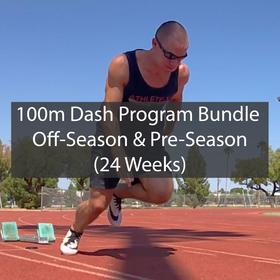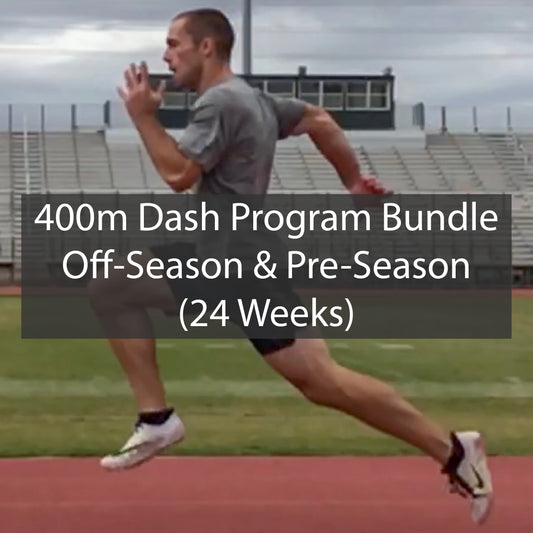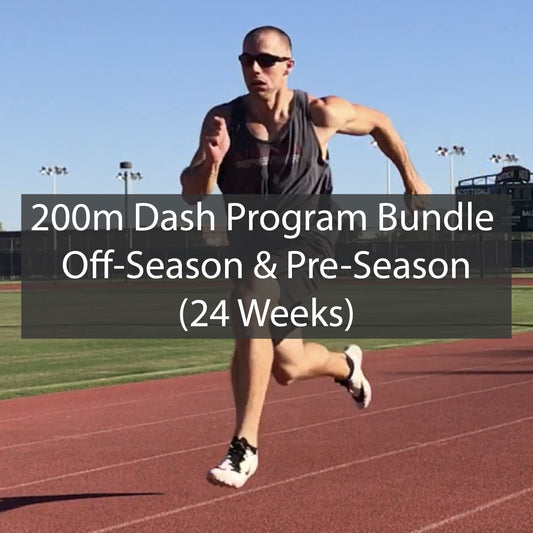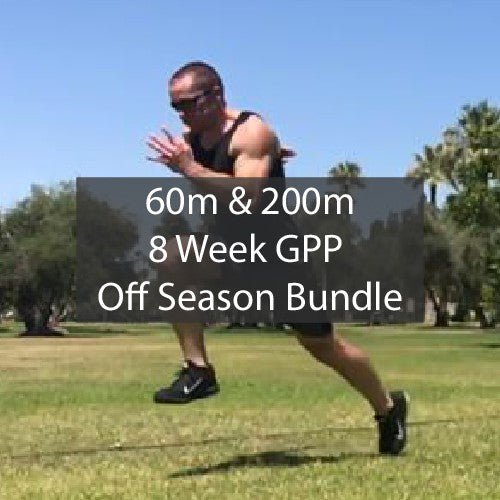Sprinting | Ultimate Training Guide To Sprint Faster With Proper Form
Sprinting | Ultimate Training Guide To Sprint Faster With Proper Form
Sprinting
Sprinting is the fastest form of movement the human body can perform.
Sprinting is not only a great way to get fit but also the best way to improve your sports performance.
Whether you want to sprint faster for track and field, get faster for your sport, or use sprinting to enhance physical fitness, this article will teach you what you need to know to get into sprinting with perfect form.
For a more advanced discussion on sprinting techniques, check out this article.
What This Page Will Cover:
- What Is Sprinting?
- 5 Elements Of Sprinting
- 3 Phases Of A Sprint
- 5 Elements Of Proper Sprinting Technique
- Sprint Training Guidelines
What Is Sprinting?
Sprinting is a form of maximal intensity anaerobic exercise which features running over short distances or a short time.
Sprint training is the best way to improve sprint performance, which in turn can boost your overall athletic performance. By training the neuromuscular system to express strength and power rapidly, sprinting increases the number of fast twitch muscle fibers to give you more speed for your sport.
Sprinting is also a great form of exercise, as it improves body composition, lowers your blood pressure, enhances cardiovascular health,
By incorporating sprint workouts into your program, you can increase your maximal speed running velocity, develop explosive power in all muscle groups, and enhance your cardiovascular fitness.

The 5 Elements Of A 100m Sprint
Whether you compete in track & field or want to run a fast 40 yard dash, it is helpful first to understand the various phases and goes through when sprinting in a race such as the 100-meter dash.
The Block Start
The block start initiates the 100-meter sprint, a key component of sprinting performance.
Athletes explosively apply horizontal force production to the starting blocks through the lead foot and rear leg to launch themselves into the race. From the start, athletes should exhibit maximal acceleration by emphasizing the force generated on each step. As the athlete increases running velocity, their posture should gradually transition to an upright, neutral position.
Your lead arm movement should go up and down quickly on the front of the body, with the rear arm doing the same on the back side of the body. This arm movement will help ensure your contact point during ground contact time can happen at the right time as the arms counterbalance the legs.

By exploding out of the starting position with a balance of aggression and efficiency, athletes can put themselves in a position to accelerate quickly up to top speed.
Once out of the blocks, the front leg foot strike must happen quickly, so the sprinter does not stumble, overstride, or slow down. Movement patterns during the early steps of sprint races should exhibit an active strike back into the ground to achieve proper running mechanics.
Avoid reaching out in front of the body, as overstriding will lead to you slowing down when you should be speeding up.
When analyzing video for proper sprint form, look to see the foot moving backward relative to the ground as it makes contact in the early steps of the sprint.
It is also worth noting that starting positions will vary, but it is important to set up in a way that allows the athlete to feel stable and be explosive as they start their sprint. Experiment with positioning and foot placement during sprint training to achieve the best results.
Acceleration Phase
Once out of the start, the acceleration phase is where athletes increase their speed, stride length & frequency and raise their posture.
By accelerating aggressively and deep into the sprint, sprinters can set themselves up to finish the race well. Acceleration can be developed through practicing acceleration training regularly.
Advanced athletes can stay lower for longer than young athletes due to their force production abilities. Keep this in mind when working on proper form, so that you do not set the same expectations for athletes of varying ability levels.
Maximal Velocity Phase
During the maximum speed phase, athletes will reach an upright position and exhibit the highest levels of stride frequency in the entire sprint.
The fastest athletes will show their talents during this phase of the sprint. At a certain point, you will reach the highest speed you can, at which point we go into speed maintenance.
At full speed, your ground contact time can be as short as 80 milliseconds.
You must practice speed training regularly to improve at the maximal velocity phase.
Speed Maintenance or Speed Endurance Phase
After reaching maximal velocity, every sprinter will decelerate or slow down. What separates elite sprinters from novice sprinters is, in part, their ability to minimize deceleration.
During the speed maintenance phase of the sprint, athletes need to relax while maintaining their posture, stride frequency, and stride length.

By relaxing and maintaining our posture, we can avoid decreasing stride length and excessive lateral movement and let our sprint cycle continue effortlessly.
When sprinting, an easy way to relax is to relax your jaw muscles and focus on applying a force impulse into the ground rather than a long, arduous push. being relaxed lets you achieve a synchronized rhythm, moving efficiently while getting the maximum amount of powerful strides with rapid turnover.
When you perform speed endurance training, it is important that you target these qualities of sprinting mechanics so you can practice good habits and run your fastest.
The Finish
As the finish line nears, athletes must maintain their form and avoid dipping too early toward the line. Many athletes slow themselves by leaning forward at the finish when they should sprint through the finish line to maintain forward motion.
It can be hard to judge how close you are to the finish line, so only experienced sprinters who have practiced the timing of this dip into the finish should approach it in this way. Most sprinters will run faster if they aim to run 5 meters past the finish line.
Improving The 3 Phases Of Sprinting
As you perform workouts for sprinters, remember this information to get the most out of your sprint training.
Acceleration Phase
The Start
During the start, we need to set ourselves up properly in the starting blocks or our stance. The standard block settings are 2 feet to the front block and 3 feet to the rear block. Block settings can be adjusted based on leg length, but this is a good starting point.
Your dominant leg should be placed in the front pedal of the blocks, with your hands placed just behind the starting line. Your foot placement in the blocks should leave your toes touching the ground, with the rest of your foot in contact with the pedals.
Once in our starting stance, we must generate force against the ground while launching our lead arm and back leg out in front of us.
Once our knee is in front of us, we need to attack down & back with our front foot as quickly as we can with as much force as we can produce.
Your ground contact time should be longer during the first few steps of the sprint, so you have more time to generate force and propel yourself with forward motion. Your cycle and arm swing will generate more speed with each step.
The initial acceleration phase of the sprint may feel like more horizontal sprinting, like you are pushing the ground away from you backward. This feeling should transition over the sprint into feeling yourself stepping down under your chest after you've progressed to around 5 meters.
Make sure to focus on having forward motion out of the blocks with your body and legs. Avoid doing a butt-kicking type of motion with your feet when initially starting.
Drive Phase
Once we have initiated the sprint with our start, we move into what many refer to as the drive phase. This is where we exert power at high levels and accelerate to high speeds.
During this phase of sprinting, our goal is to build momentum as we increase our sprinting speed. We want to move quickly through a full range of motion, letting the knees come up and then rapidly attacking down & back at the track.
The drive phase will last anywhere from 15 meters for beginner sprinters to 30 meters for advanced sprinters. How strong and fast you are will dictate how long you can for.
During the drive phase, our stride length and stride frequency should gradually increase, and our posture should rise from a slight lean forward into an upright position.
Late Acceleration Phase
Once out of our drive phase, we reach the late acceleration phase. Here our goal is to get into the right posture and rhythm to set ourselves up for maximum speed.
During late accelerative sprinting, you can focus on transitioning from building momentum to letting your legs cycle as quickly as possible. You should not force your stride frequency to increase but rather allow your legs to cycle as you manage your posture and stay relaxed.
During this phase of the sprint, we will see shorter ground contact times than are seen in early accelerative sprinting as we apply optimal vertical forces in short periods of time.
Top Speed Phase
Top speed sprinting technique should exhibit an upright posture while applying optimal vertical forces.
As we accelerate up to top speed, the following will occur:
- Stride length will increase.
- Stride frequency will increase.
- Our body gradually straightens to an upright position.
If you can exhibit optimal sprinting technique, you should be able to spend 1 to 3 seconds at or near your maximum speed. The longer you can hold the maximum velocity sprinting phase, the better times you will run.
You should emphasize applying vertical force into the ground with shorter ground contact times than you'd see earlier in the sprint. Because gravity is the primary force we must overcome, our lead leg needs to emphasize an abrupt, aggressive downward strike into the ground.

By maintaining an upright upper body position and proper form, you can strike the ground effectively and then let your leg cycle in a quick but relaxed manner into the next stride.
If your stride cycle begins to fall apart, ensure you are not pushing back against the ground too much. When at maximum speed, we do not have time to push backward. Instead, we strike the ground like a hammer and let the leg quickly recover to the front side.
Once you reach the high knee position, which really isn't that high, make sure you emphasize a rapid downward strike, letting the hip flexors turn off so the glute muscles control extension to cause greater force generation.
Speed Maintenance & Speed Endurance
The key to speed maintenance is to let your legs cycle quickly as you maintain posture and stay relaxed.
Once you have progressed through the acceleration and maximal velocity phases, the only thing you can do to improve your time is to prevent yourself from slowing down.
Every sprinter will decelerate at the end of a 100m, 200m, or 400m dash, but the best athletes minimize this loss of speed with proper sprint technique.
If you manage the posture of your body whilst sprinting, you can ensure that your ground contacts and stride cycle can stay consistent.
During this phase, we need to emphasize staying relaxed and letting our legs cycle quickly rather than forcing them to do so.
You can think of it like riding a wave, where you would paddle hard to catch the wave, and then you're along for the ride. The same pertains to sprinting - accelerate strongly and reach maximum speed, at which we relax and hang on for dear life.
To train qualities like speed endurance, you can start off with sprint interval training and then progress to speed endurance training sessions over time. Sprint interval training, such as tempo endurance, can be done at lower intensity levels with short rest periods. Speed endurance should be done at high intensity levels with longer recovery periods.
5 Elements of Proper Sprinting Mechanics
Sprinters need to focus on body posture, ground contact mechanics, leg recovery mechanics, rhythm and relaxation.
Sprinting Posture
Posture refers to your overall body position, including your spine, torso, pelvis, and legs. This is a crucial aspect of sprinting technique, as your posture dictates the movements your limbs can make.
During the acceleration phase, our posture exhibits a slight forward lean, but we are not bent over at the hips. When your foot leaves the ground, you should see a straight line from your toes up through your hips, spine, and head.
When reaching maximum speed, your posture should move into an upright position, with a vertical torso and neutral pelvis. This allows you to balance front-side arm movement and backside leg action to promote proper force production and prevent injury.
By keeping a good posture, the athlete's center of mass will stay in a place that allows for consistent sprinting using good mechanics.
Ground Contact Mechanics
Ground contact mechanics refers to how your foot makes contact with the ground. In sprinting, ground contact times can be as short as 0.08 seconds, which means there is no room for error.
Your foot should vertically strike the ground, with the foot moving backward relative to the body as it approaches the ground.
The most common mistake in beginner sprinters is letting the foot crash forward into the ground.
When you are sprinting, you have to ensure that you do not passively contact the ground with your foot moving forward at the moment of impact. This creates braking forces that slow you down and cause injury.
Instead, attack down & back into the ground, matching up the speed & direction of your foot with the natural speed of the track moving under you.
Leg Recovery Mechanics
While the attack down into the ground propels us into the next stride, how we recover or pick up the leg dictates the quality of the following stride. The time we spend in the air as the leg recovers is called the flight phase.
Many athletes tend to push or extend for too long, leading their legs to stay behind them, their hips to drop, and their next ground contact to land in front of the body. This is not good, as it will slow you down and increase your risk of injury.
Instead, once we feel our foot makes contact with the ground, we want to relax that leg and let it cycle through on its own during the flight phase. We should not emphasize pushing back behind the body or driving the knee as high as possible. Instead, we emphasize the downward strike into the ground and then let the rest of the movement happen on its own.
When performed correctly, leg recovery will happen in a circular motion.
One cue that can be helpful for leg recovery is to float the thigh or knee through rather than driving it up.
Rhythm
Rhythm is an important quality for sprinters, as our progression from forceful to quick strides dictates how well and how far we can accelerate.
The rhythm of proper sprinting form needs to feel like a crescendo, going from slower to faster as you sprint.
You should feel quick in the first step but not reach maximum stride frequency too soon. We want to build up our stride frequency over most of the acceleration phase so that we can stay efficient and reach maximal velocity at the right time.
To improve your sprinting rhythm, you can utilize wicket sprints, build up accelerations, and focus on having a smooth progression as you accelerate.
Relaxation
Last, being able to stay relaxed mentally and physically is crucial to improve performance in sprinting. If you try too hard to sprint faster, your muscles will tighten up, and you will not move quickly.
For example, if the muscles that control extension stay activated for too long because you are trying too hard, your hip flexors cannot rapidly bring the leg to the front side. Your muscles are essentially playing tug of war with each other.
Sprinters need to sprint with maximal intensity, but this does not mean that we fire every muscle fiber in our body at the same moment.
Relaxation in sprinting allows for the proper timing and sequencing of muscle activation to allow for the fastest movements.
If you can stay relaxed mentally and find the feeling of letting your body move fast rather than forcing it to move fast, you will have mastered the art of sprinting with relaxation. balancing relaxation with intensity is required to exhibit good sprinting technique.
Sprint Form Checklist and Reminders
To make sprinting simple, here are a couple of checklist items you can go through to remind yourself how to improve sprinting and run with proper sprinting form.
- Ensure your posture is upright, not bending forward at the hips or leaning back.
- Focus on attacking the ground abruptly, generating vertical force into the ground to overcome gravity.
- Once you feel the ground, let your leg cycle through in a relaxed manner.
- Avoid forcing your leg to extend behind you or pulling yourself horizontally across the ground.
- Be very aggressive during acceleration, relaxing through maximum speed and speed maintenance phases.
- Run through the finish line rather than running to the finish line.
- Never let your foot strike with positive foot speed, where your foot crashes forward into the ground.
Preventing Injury Through Proper Sprinting Form
One of the great benefits of improving your sprinting technique is that it can also help you avoid serious injury.
When we move correctly, we can use the right muscles at the right time in ways that they were designed to work. When we exhibit poor form, our muscles and tendons must work extra hard to sprint down the track.
By avoiding overstriding, you can prevent hamstring injuries and hip flexor injuries. If your leg contacts too far in front of the body, this puts unnecessary stress on your hamstrings and can lead to a hamstring strain.
Similarly, if we maintain dorsiflexion at the ankle, we can protect our lower leg muscles and Achilles tendon. If we instead contact the ground with our toes extended downward too much, the Achilles tendon has to lengthen rapidly, which can cause tendonitis over time.
Because of this, emphasizing proper sprinting technique will help you perform better and stay healthy, avoiding injury so you can enjoy sprinting more.
If you get injured, speak with a sports medicine professional to help get you back on the right track.
Frequently Asked Sprinting Questions
Does Pumping Your Arms Make You Run Faster?
Pumping your arms properly can make you run faster, but this must be done in a relaxed manner.
If you work too hard with your arms, you may disrupt your leg and torso movements, slowing you down.
The primary role of the arms in sprinting technique is to prevent excessive torso rotation. With that in mind, focus on letting your arms swing naturally and flexibly, only adjusting them if you see excessive shoulder and torso rotation.
Instead of focusing too much on the arms, make sure that you sprint with all-out effort while staying relaxed, and aim for a gradual transition toward quicker steps and a more upright posture.
Should Your Heels Touch the Ground When Sprinting?
Your heels may tap the ground in sprinting but should not be the main point of contact.
The faster you move horizontally over the ground, the more you should contact on the ball of the foot.
During mid-stance, when your foot is on the ground and your knees parallel, your heel will likely tap the ground briefly as your entire body passes over your point of ground contact.
This should not be felt by the athlete or done intentionally, but if you see it happening, you can know that this is natural.
Ground contact times with proper sprinting technique will be around 80-90 milliseconds, whether your heel taps or not.
How Long Does It Take To Develop Proper Sprinting Technique?
Sprinting technique can take years to develop, but improvements can begin on day one.
As with any complex motor task, it is vital to allow yourself the time to learn it. If you were going out to learn some new skill, you wouldn't expect to master it in one day.
With sprinting form, you can make improvements every day. With that in mind, you should also focus on how you can consistently improve your sprinting technique over long periods to keep training and getting better sprinting.
What Muscles Should I Workout for Sprinting?
The glutes, hamstrings, quads, calves, core, and shoulders are the most critical muscles for sprinting.
Nearly all muscles will show some amount of activation in the body whilst sprinting. If you exhibit proper sprinting mechanics, you will find that muscles in the lower body, and upper body all work together to get you sprinting down the track.
If you want to target muscles for sprinting in your strength training routine, you can emphasize exercises that target the following muscles:
- Glutes
- Quads
- Hamstrings
- Calves
- Core
- Shoulders
- Hip Extensors
- Hip Flexors
How much weight you use and which exercises you choose will depend on your training history and needs, but it is wise to pick exercises that use many muscle systems at once.
For example, squats, deadlifts, Olympic lifts, jumps, plyometric drills, and resisted sprinting can all help get you stronger for sprinting.
When performing exercises for speed, make sure that you focus on high-intensity, quality movements rather than trying to make yourself tired.
Neurological Considerations For Strength Training For Sprinters
Training to get strong is essential, but eventually, athletes may need to progress on to more specific forms of training to see further progress.
For example, if you do deadlifts with 75% effort, you will get stronger for a while. Eventually, though, you may need to work with near-maximal efforts to see progress.
With regards to sprinting, strength training exercises that are being used to develop power and explosive strength should be programmed with consideration for how rapidly the athlete recruits muscle and accelerates the load.
If your general strength training is no longer transferring, you should consider focusing more on the rate of force development and neurological aspects of sprinting.
Sprint Training Guidelines
Now that you are ready to start sprint training, it is important that you follow some guidelines and best practices to make the most of your sprinting routine.
First, sprint training sessions must be done at a very high-intensity level. Your first weeks of training can be done around 85%, but eventually needs to progress up to 95% or higher intensities.
Second, because intensities are very high in sprinting, we need to take long enough rest periods so that we can be recovered between sprints. If recovery periods are too short, you will not run fast enough each sprint to get the adaptations you want from sprinting.
Third, your training volume in sprinting sessions should be moderate, not maximal. If you do too much sprinting, you will get fatigued or injured, which will hinder your progress. For an acceleration or speed training session, stay below 300 meters of total sprinting volume until you fully understand how your body reacts to your workout routine.
Fourth, ensure you know what qualities you are trying to target with each training session. If your goal is to develop maximal velocity, then you should only sprint over short distances to avoid the deceleration phase. For example, if you reach maximal velocity at 40 meters, then doing 80-meter sprints would not be appropriate for developing speed.
Fifth, do not sprint over distances where you cannot maintain your running form. If you can only sprint fast to 100 meters before your technique starts to fall apart, you should avoid fast sprints beyond that distance. Once you can maintain good running form through that distance, you can increase it to further work on speed endurance.
Sixth, incorporate other exercises into your sprint program such as sled sprints and medicine ball throws, as these can help develop the specific strength and power requirements you need to run fast.
Seventh, trust in the training process. Speed development takes time, and you must be patient as you train to get faster. By utilizing the right training methods and following the guidelines in this article, you can have fun while getting faster over time.
Conclusion
Whether you are just starting or trying to make it to the Olympic games, sprinting is a great way to get faster, become more athletic, and improve your cardiovascular health.
Incorporate sprint running in your program, and you will see that the benefits of sprinting on health and performance are worth the hard work.
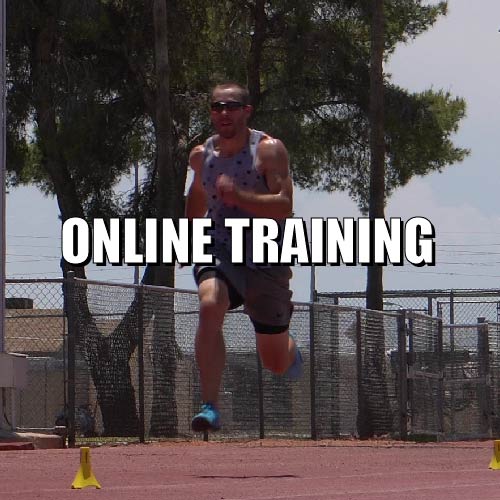
Online Training Group
Get workouts sent to your phone to help you get stronger, sprint faster, and jump explosively.
Sprint Training Articles
View all-
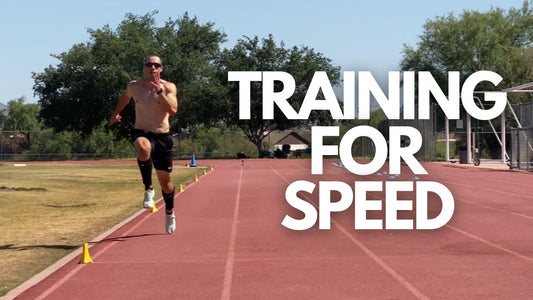
Training For Speed - Methods, Progressions & Ti...
Speed training is fundamentally the primary way to train in order to sprint faster. Social media influencers and coaches throw the term speed training around loosely, when in reality it...
Training For Speed - Methods, Progressions & Ti...
Speed training is fundamentally the primary way to train in order to sprint faster. Social media influencers and coaches throw the term speed training around loosely, when in reality it...
-
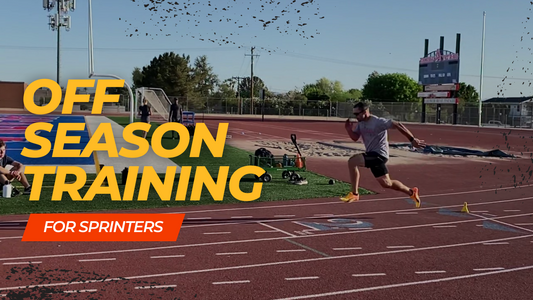
How Should Sprinters Train In Their Off Season?
After a long season of training and competition, many sprinters find themselves wondering what they should do once the season has come to a close. Some continue to train hard,...
How Should Sprinters Train In Their Off Season?
After a long season of training and competition, many sprinters find themselves wondering what they should do once the season has come to a close. Some continue to train hard,...
-
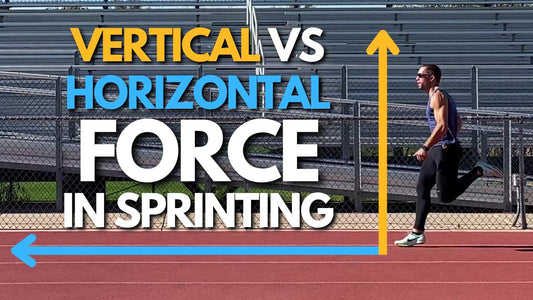
Force Production In Sprinting | Is Vertical Or ...
In discussions surrounding sprint performance, coaches and researchers have debated whether vertical force or horizontal force is more important for running fast. While many will pick a side and claim...
Force Production In Sprinting | Is Vertical Or ...
In discussions surrounding sprint performance, coaches and researchers have debated whether vertical force or horizontal force is more important for running fast. While many will pick a side and claim...
Sprint Training Programs
-
100 Meter Dash Training Program Off-Season & Pre-Season Bundle
Regular price $47.00 USDRegular priceUnit price / per$99.00 USDSale price $47.00 USDSale -
400m Dash Off-Season & Pre-Season Training Program Bundle
Regular price $47.00 USDRegular priceUnit price / per$95.97 USDSale price $47.00 USDSale -
200m Dash Off-Season & Pre-Season Training Program Bundle
Regular price $47.00 USDRegular priceUnit price / per$95.97 USDSale price $47.00 USDSale -
Indoor Off Season Bundle - 60 Meter & 200 Meter Dash GPP Training Programs
Regular price $62.00 USDRegular priceUnit price / per$78.00 USDSale price $62.00 USDSale



